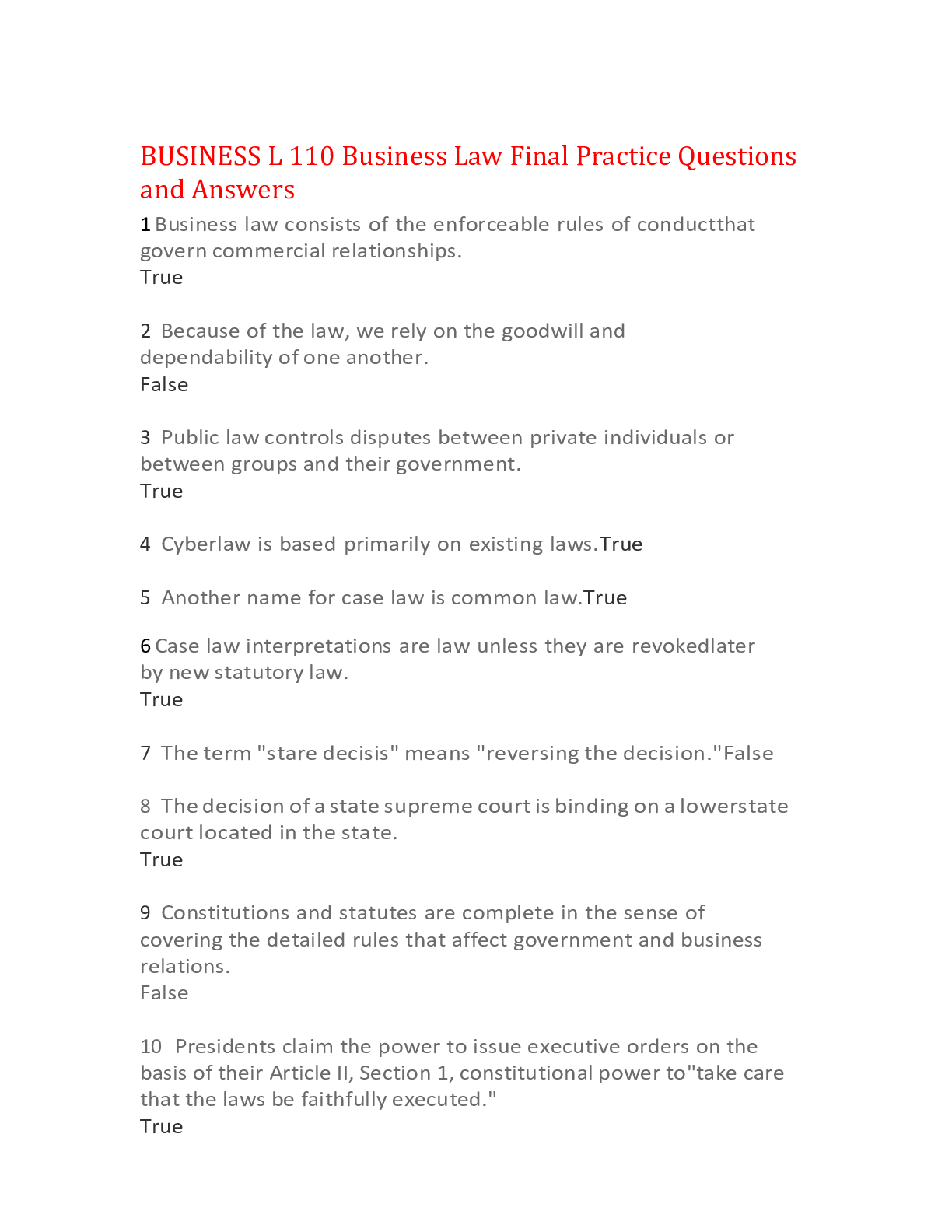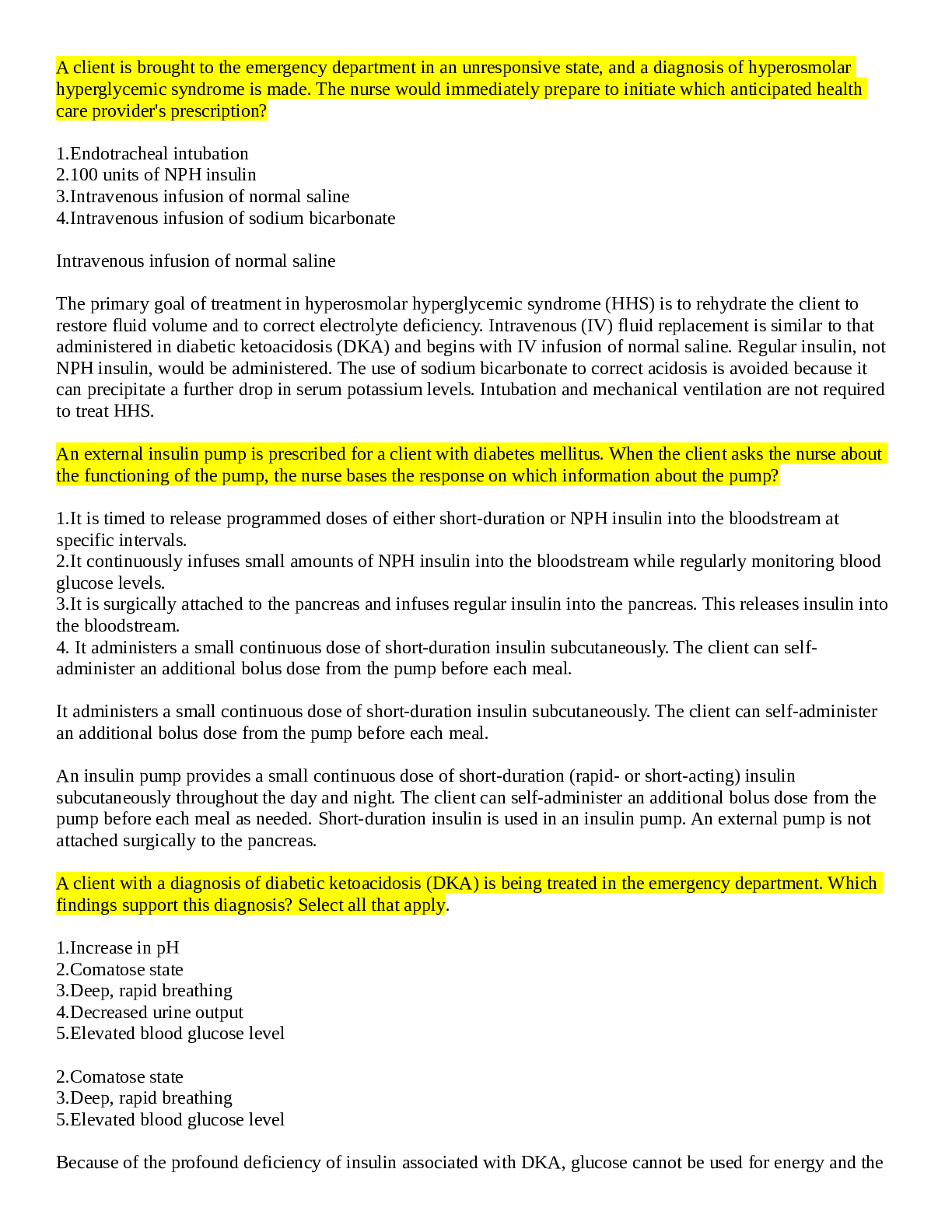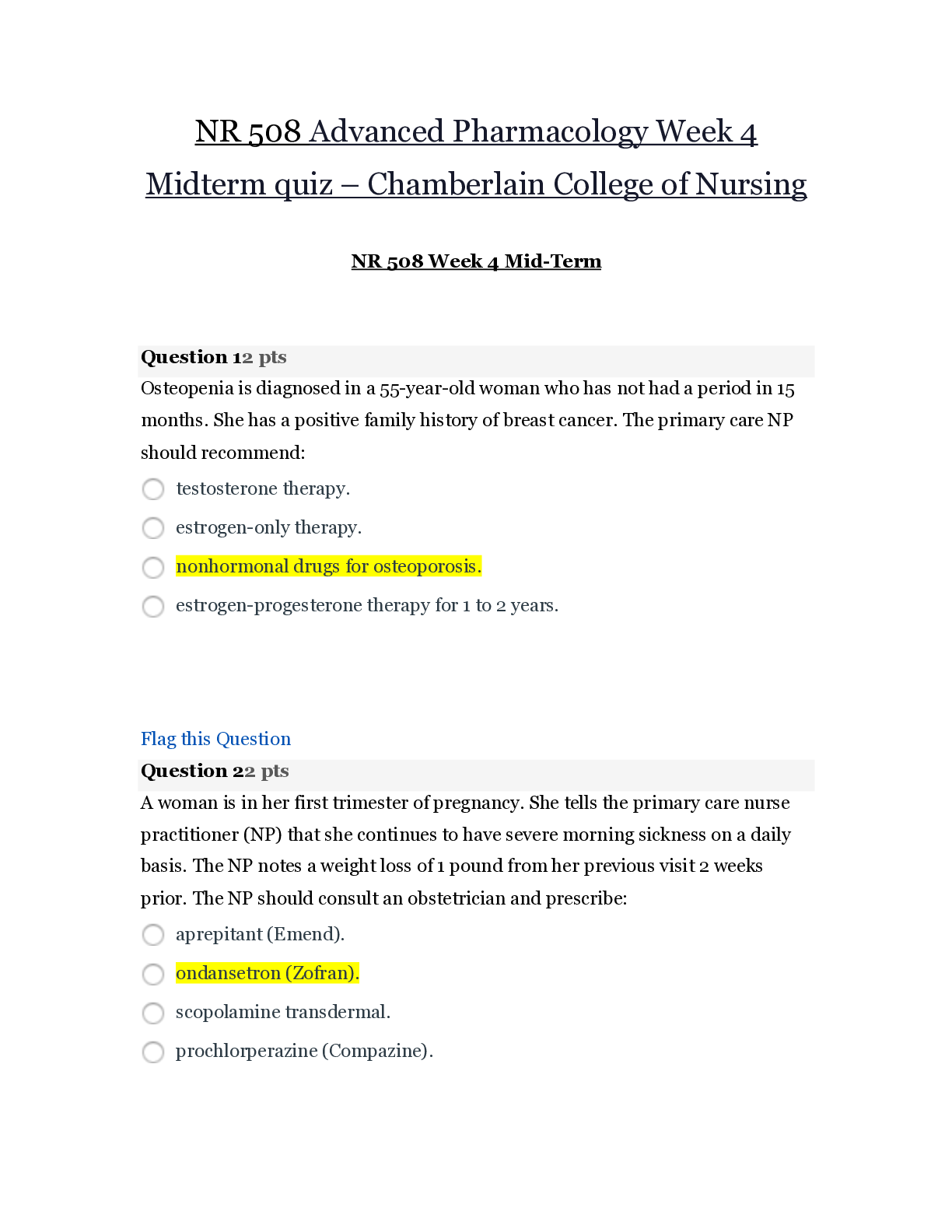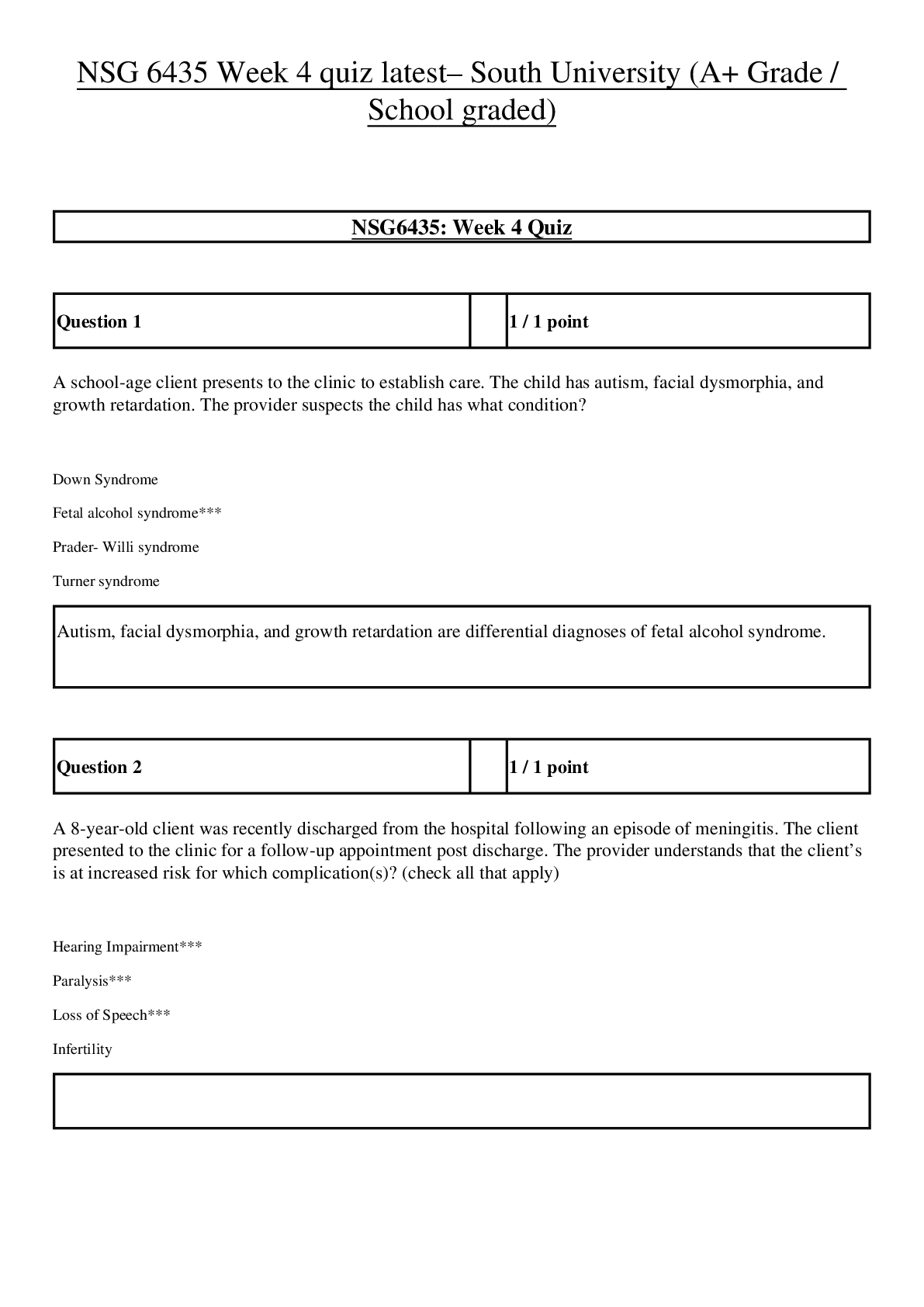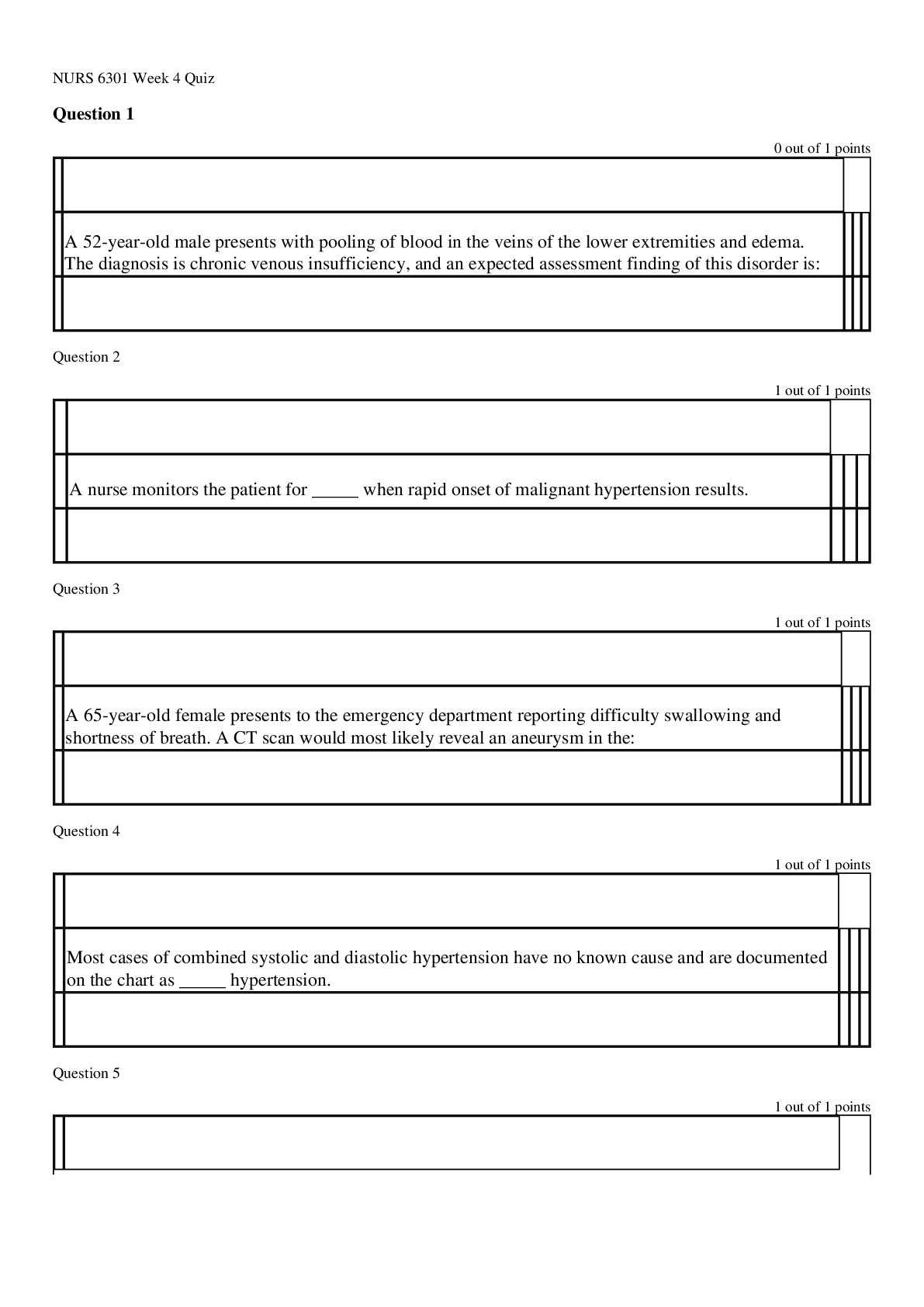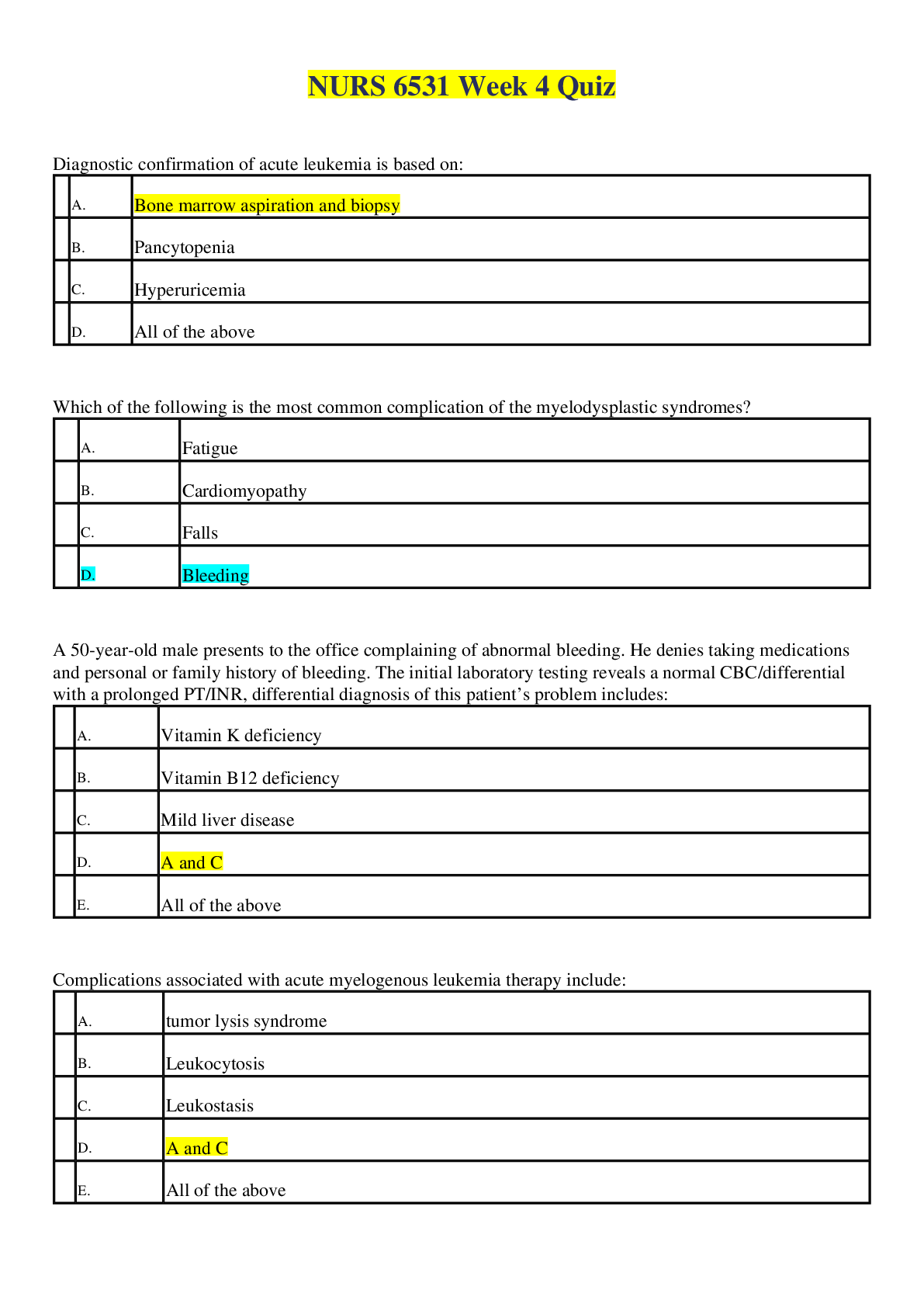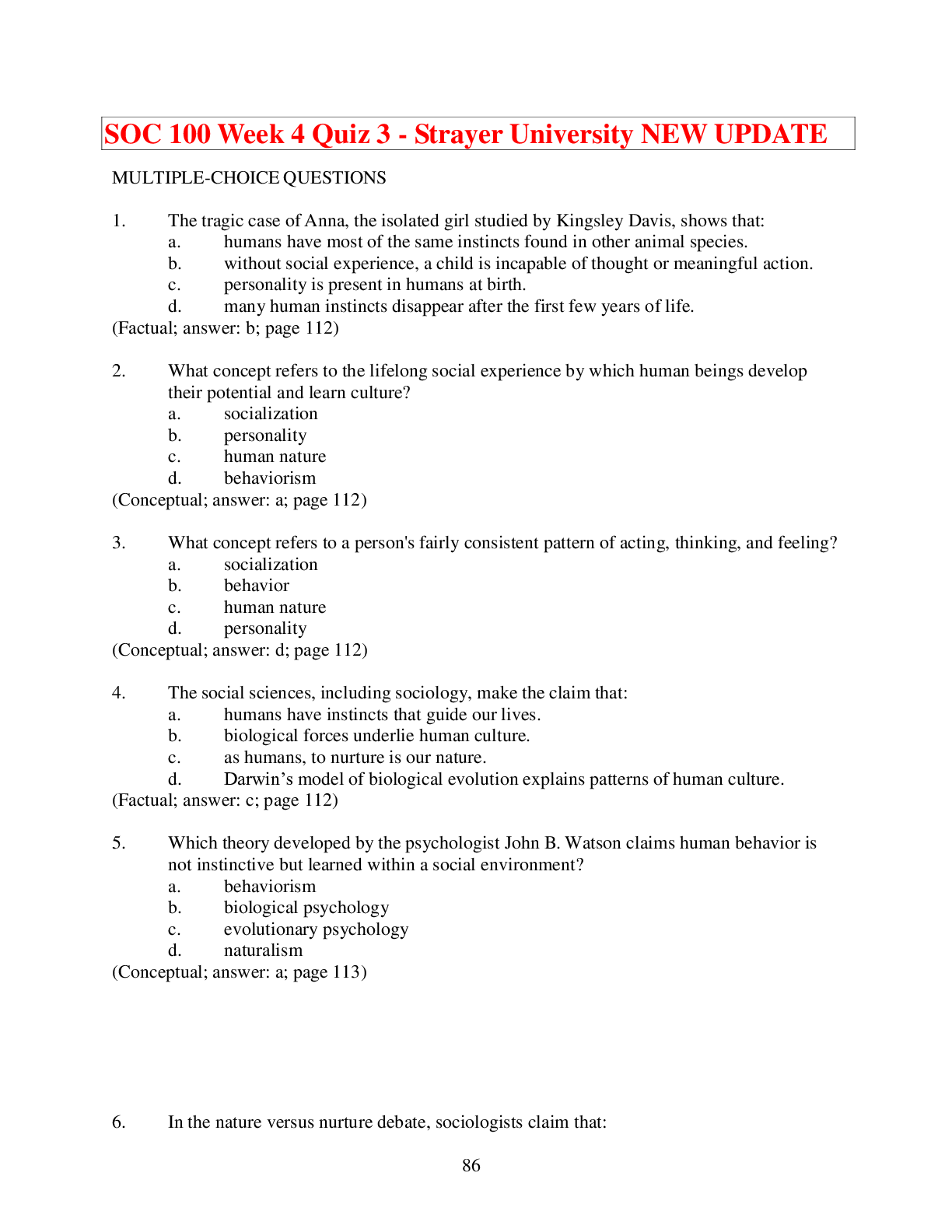NURS 6531 week 4 quiz Questions and Answers,100% CORRECT
Document Content and Description Below
NURS 6531week 4 quiz Questions and Answers Diagnostic confirmation of acute leukemia is A Bone marrow aspiration and . biopsy B Pancytopenia . C Hyperuricemia . D All of the above... . Which of the following is the most common complication of the myelodysplastic syndromes? A Fatigue . B Cardiomyopa . thy C Falls . D Bleeding . A 50-year-old male presents to the office complaining of abnormal bleeding. He denies taking medications and personal or family history of bleeding. The initial laboratory testing reveals a normal CBC/differential with a prolonged PT/INR, differential diagnosis of this patient’s problem includes: A Vitamin K . deficiency B Vitamin B12 . deficiency C Mild liver disease . D A and C . E. All of the above Complications associated with acute myelogenous leukemia therapy include: A tumor lysis . syndrome B Leukocytosis . C Leukostasis . D A and C . E. All of the above goal INR for this patient should be: A INR 1.8- . 2.5 B INR 1.8- . 3.2 C INR 2.0- . 3.0 D INT 2.5 . -3.5 A 28-year-old female presents to the office requesting testing for diagnosis of hereditary thrombophilia. Her father recently had a deep vein thrombosis and she is concerned about her risk factors. The nurse practitioner explains that: A The patient should start anticoagulant therapy . immediately. B Hereditary thrombophilia does not always require . anticoagulation therapy. C Women of childbearing age cannot take anticoagulant . therapy. D Genetic and risk management counseling are . recommended. E. B and D A middle-aged female presents complaining of recent weight loss. The physical exam reveals an enlarged painless cervical lymph node. The differential diagnosis for this patient’s problem includes: A Infection . B Toxoplasmosis . C Mononucleosis . D All of the . above E. None of the above Which of the following patient symptoms is consistent with an acute myocardial infarction? A Chest . heaviness B Dyspnea . D All of the . above Important education for patients with moderate or severe aortic stenosis includes: A Avoiding competitive sports . B Reassurance that the condition . is benign C Medication prophylaxis to . prevent stroke D All of the above . During the physical examination, the nurse practitioner notes the presence of an S4 gallop. The nurse practitioner realizes that an S4 occurs: A After the . S3 B Before the . S1 C After the . S1 D Before the . S3 A 57-year-old male presents to urgent care complaining of substernal chest discomfort for the past hour. The EKG reveals ST elevations in Leads II, III, and AVF. The nurse practitioner is aware that these changes are consistent with which myocardial infarction territory? A Inferior . wall B Anterior . wall C Apical wall . D Lateral . wall A 28-year-old female presents to urgent care complaining of a fluttering feeling in her chest. She has been ill with vomiting and diarrhea for two days, but states the GI symptoms have now stopped. She just is concerned about the heart rate. The EKG reveals multifocal PVCs. The patient’s laboratory values are: serum potassium 2.6 mEq/L, serum sodium 144 mEq/L, serum chloride 90 mEq/L, and blood glucose 98 mg/dl. The nurse practitioner believes that the patient’s PVCs are likely caused by which of the following: B Hypoxemia . C Hypokalemia . D None of the . above Diastolic murmurs are caused by regurgitation across the: A Aortic valve . B Pulmonic . valve C Tricuspid . valve D A and B . An 88-year-old female presents complaining of “liquid” draining from her leg. She denies pain or injury. The physical exam reveals an irregularly shaped shallow ulceration on the posterior left lower extremity above the ankle. An area of warmth and erythema surround the lesion. The nurse practitioner suspects: A A venous stasis . ulcer B An arterial ulcer . C A neuropathic . ulcer D Ischemia ulcer . A patient presents to the office with a blood pressure 142/80. This patient is classified as having: A Normal blood . pressure B Prehypertension . C Stage 1 . hypertension D Stage 2 . hypertension Which of the following are essential components of the vascular physical exam? A Blood . pressure B Foot exam . C Abdominal . exam D All of the . above The National Cholesterol Education Program’s Adult Treatment Panel III recommends that the goal for low density lipoproteins in high risk patients be less than: A 160 . mg/dL B 130 . mg/dL C 100 . mg/dL D 70 . mg/dL Which of the following is not a lifestyle risk factor associated with hypertension? A High dietary fat . intake B Sedentary life . style C Obstructive sleep . apnea D High alcohol . intake A patient presents to urgent care complaining of dyspnea, fatigue, and lower extremity edema. The echocardiogram reveals and ejection fraction of 38%. The nurse practitioner knows that these findings are consistent with: A Mitral . regurgitation B Systolic heart . failure C Cardiac myxoma . D Diastolic heart . failure American Heart Association goals to promote ideal cardiovascular health in women include which of the following? A Smoking cessation . B > 100 minutes /week physical . activity C Blood pressure < 120/80 . D A and C . E. All of the above Diagnostic confirmation of acute leukemia is based on: • Question 2 Which of the following is the most common complication of the myelodysplastic syndromes? • Question 3 A 50-year-old male presents to the office complaining of abnormal 0 out of 1 points 1 out of 1 points bleeding. He denies taking medications and personal or family history of bleeding. The initial laboratory testing reveals a normal CBC/differential with a prolonged PT/INR, differential diagnosis of this patient’s problem includes: • Question 4 Complications associated with acute myelogenous leukemia therapy include: • Question 5 1 out of 1 points 1 out of 1 points Warfarin (Coumadin) is prescribed for a frail, elderly male with new onset atrial fibrillation. The goal INR for this patient should be: • Question 6 1 out of 1 points A 28-year-old female presents to the office requesting testing for diagnosis of hereditary thrombophilia. Her father recently had a deep vein thrombosis and she is concerned about her risk factors. The nurse practitioner explains that: • Question 7 A middle-aged female presents complaining of recent weight loss. The physical exam reveals an enlarged painless cervical lymph node. The differential diagnosis for this patient’s problem includes: • Question 8 Which of the following patient symptoms is consistent with an acute myocardial infarction? 0 out of 1 points 1 out of 1 points Important education for patients with moderate or severe aortic stenosis includes: • Question 10 1 out of 1 points During the physical examination, the nurse practitioner notes the presence of an S4 gallop. The nurse practitioner realizes that an S4 occurs: • Question 11 0 out of 1 points A 57-year-old male presents to urgent care complaining of substernal chest discomfort for the past hour. The EKG reveals ST elevations in Leads II, III, and AVF. The nurse practitioner is aware that these changes are consistent with which myocardial infarction territory? • Question 12 A 28-year-old female presents to urgent care complaining of a fluttering feeling in her chest. She has been ill with vomiting and diarrhea for two 1 out of 1 points days, but states the GI symptoms have now stopped. She just is concerned about the heart rate. The EKG reveals multifocal PVCs. The patient’s laboratory values are: serum potassium 2.6 mEq/L, serum sodium 144 mEq/L, serum chloride 90 mEq/L, and blood glucose 98 mg/dl. The nurse practitioner believes that the patient’s PVCs are likely caused by which of the following: • Question 13 Diastolic murmurs are caused by regurgitation across the: • Question 14 1 out of 1 points 1 out of 1 points An 88-year-old female presents complaining of “liquid” draining from her leg. She denies pain or injury. The physical exam reveals an irregularly shaped shallow ulceration on the posterior left lower extremity above the ankle. An area of warmth and erythema surround the lesion. The nurse practitioner suspects: • Question 15 1 out of 1 points A patient presents to the office with a blood pressure 142/80. This patient is classified as having: Which of the following are essential components of the vascular physical exam? • Question 17 The National Cholesterol Education Program’s Adult Treatment Panel III 1 out of 1 points recommends that the goal for low density lipoproteins in high risk patients be less than: • Question 18 Which of the following is not a lifestyle risk factor associated with hypertension? • Question 19 A patient presents to urgent care complaining of dyspnea, fatigue, and 1 out of 1 points 1 out of 1 points lower extremity edema. The echocardiogram reveals and ejection fraction of 38%. The nurse practitioner knows that these findings are consistent with: • Question 20 1 out of 1 points American Heart Association goals to promote ideal cardiovascular health in women include which of the following? Friday, September 23, 2016 1:49:01 PM EDT [Show More]
Last updated: 1 year ago
Preview 1 out of 16 pages

Reviews( 0 )
Document information
Connected school, study & course
About the document
Uploaded On
Sep 20, 2021
Number of pages
16
Written in
Additional information
This document has been written for:
Uploaded
Sep 20, 2021
Downloads
0
Views
171

















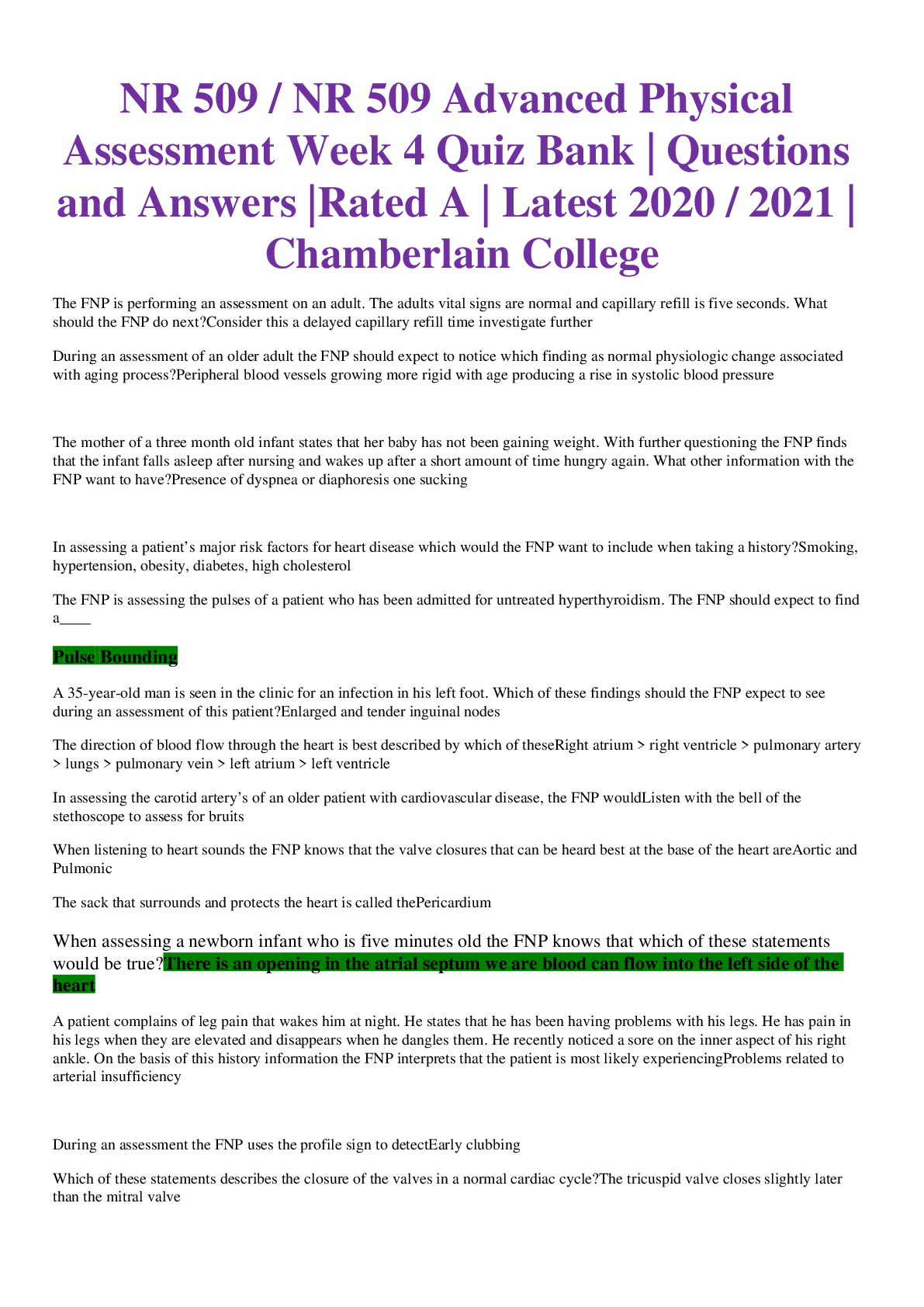
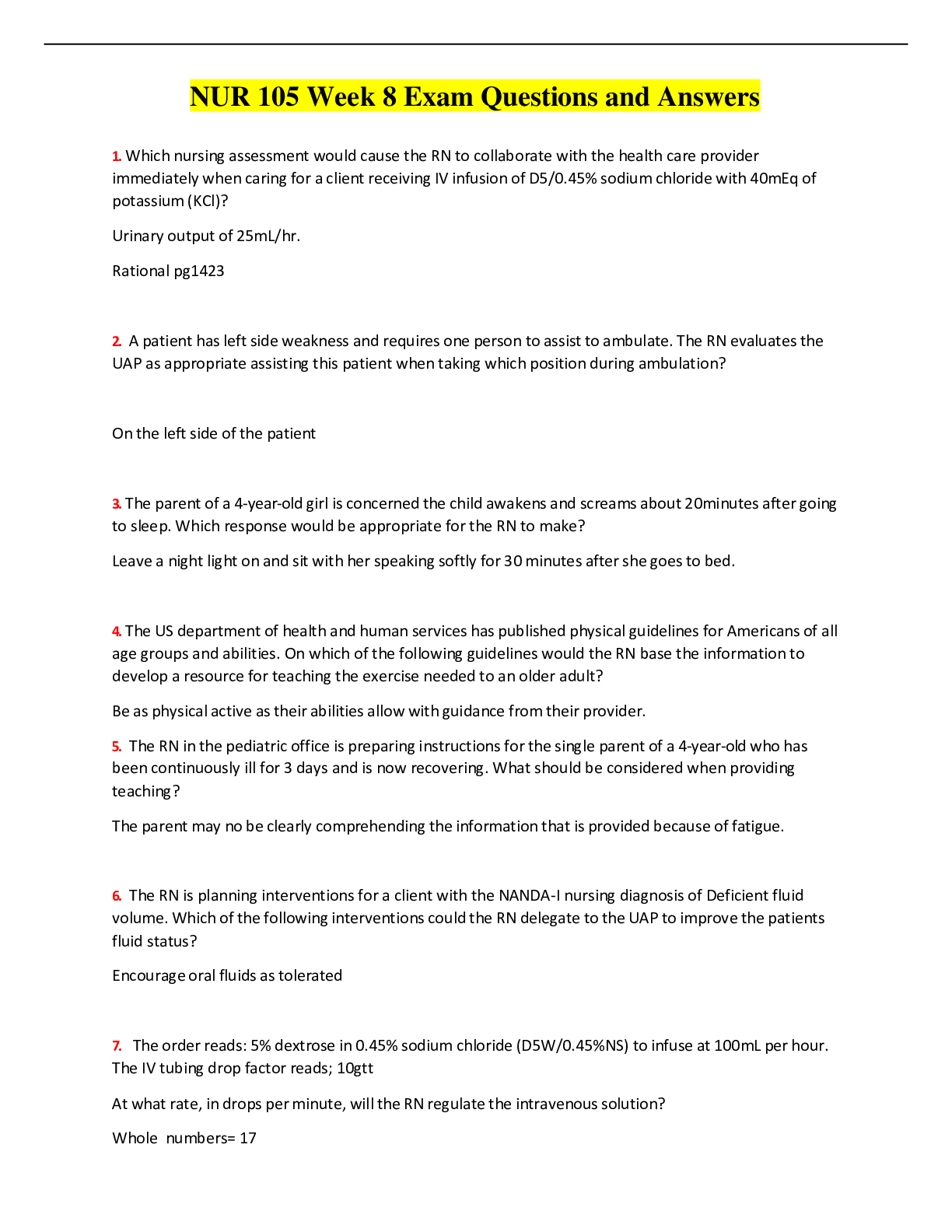
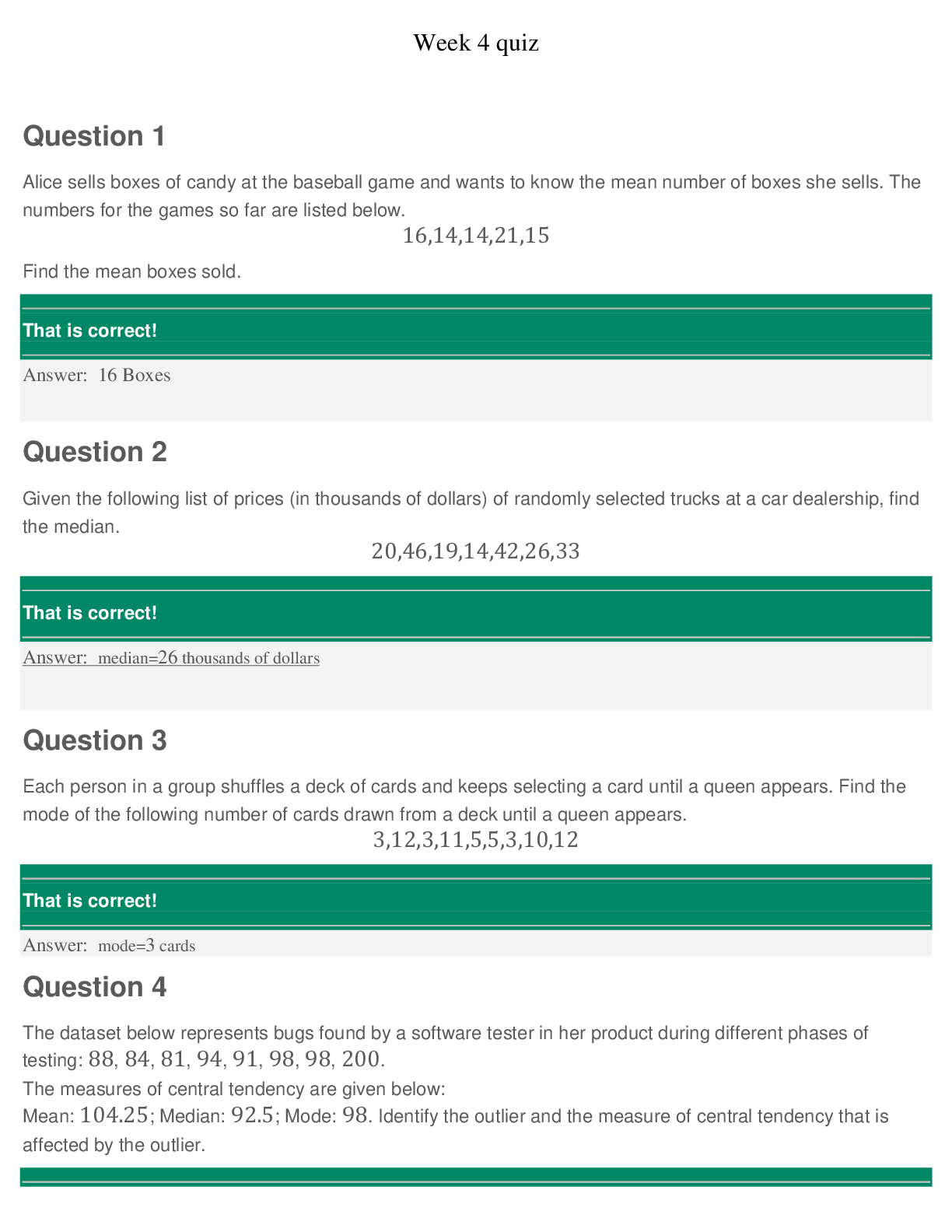
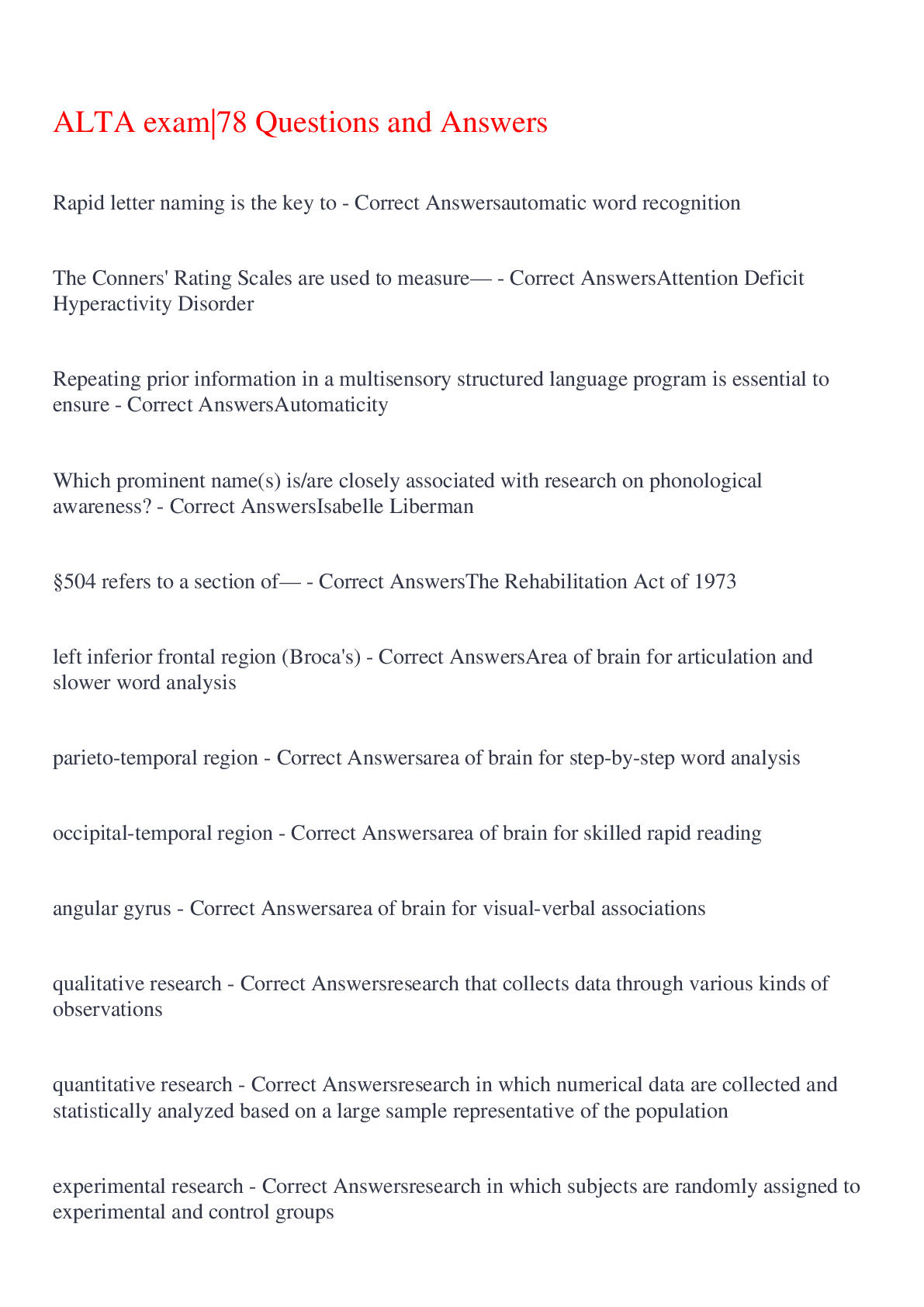

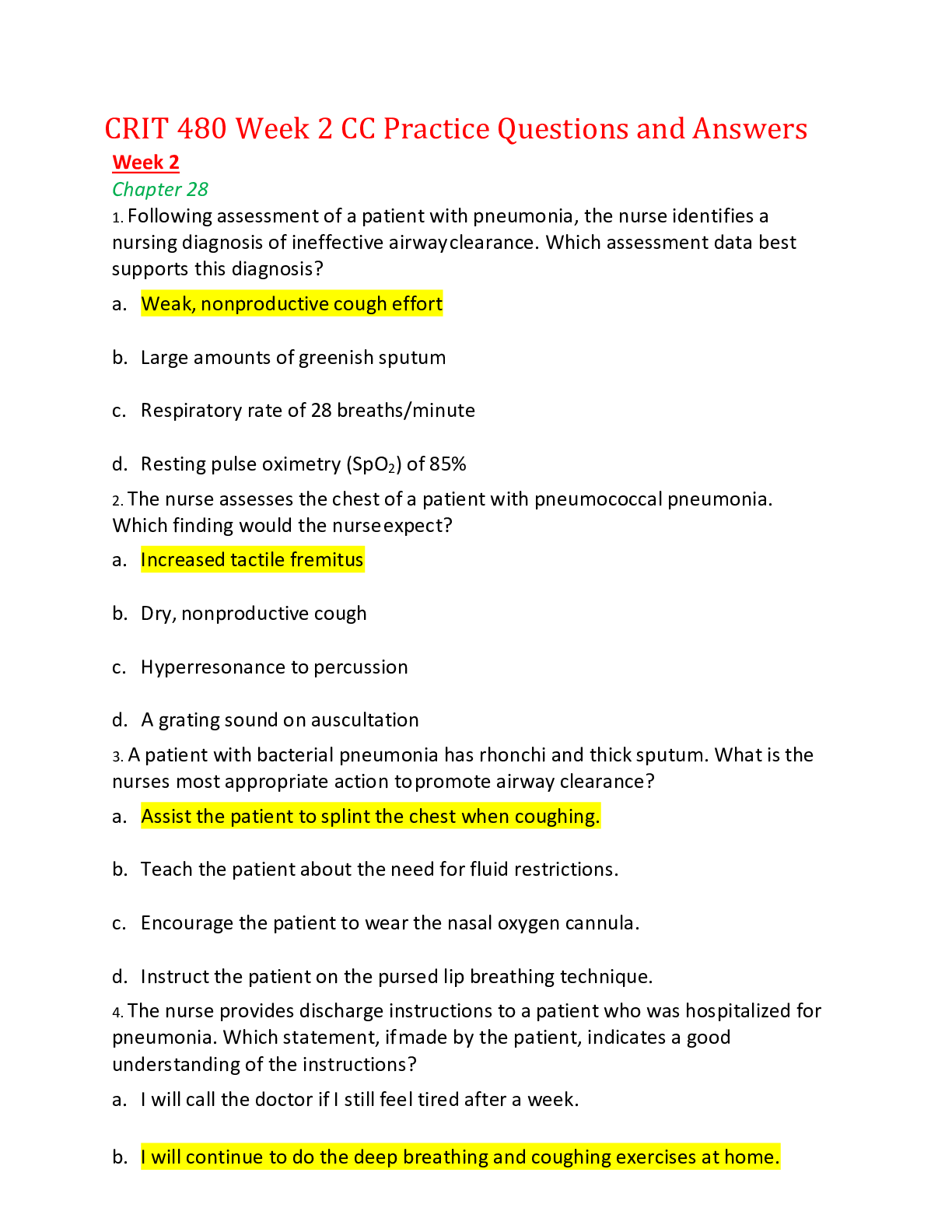
 (1).png)
